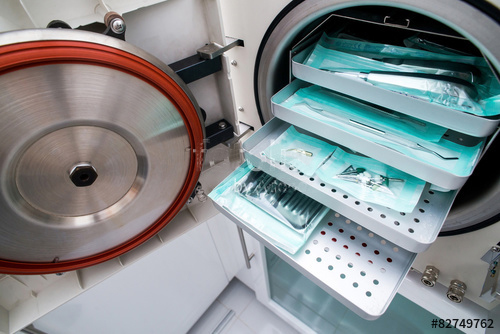- Igiene e sicurezza
- 0 likes
- 14843 views
The sterilization of the working tools is the final stage of a sterilization process that involves first decontamination, washing, disinfection and if necessary, the packaging. The cold-sterilization can be performed by means of suitable solutions, or hot utilizzanto apparecciature that produce heat at high temperatures. Not all sterilizations are equal, for each job needs can and should be used the type of device suitable for the purpose, therefore suitable for the application of the tools that are to be sterilized. For example, a dentist, a tattoo artist or a podiatrist, must be used, except in certain cases, an autoclave with saturated steam (Class B), while a beauty center or primary care physicians can use an autoclave or in class S N or a dry heat sterilizer. Not even the fact autoclaves are all the same.
In this article we will analyze how the sterilization of instruments in an autoclave and its proper preparation.
Autoclaving
The sterilization process in the autoclave is carried out by means of steam.
fundamental assumption is that the steam is saturated, which means in a constant balance between temperature and pressure, so as to perfectly lick the surface of the instruments and give him the right heat evenly. The heat released on the instrument (134 ° C), so will alter the nature of the present micro-organisms, allowing sterilization.
Because there is only saturated steam into the autoclave chamber is essential that the air is evacuated. Any residual air, not mixing with the steam produced, is compatterebbero forming of the bags more or less large and wandering inside the sterilization chamber and the instrument (or the part of it) that was to be found in contact with a bag air would not be sterilized because they do not reach the correct sterilization temperature during the necessary time.
The air transfers heat much more slowly than the steam and, in the autoclave that handles very short times at lower temperatures (in genere134 ° C for 4 min) compared to other Waste Equipment, this would not allow the sterilization of the instruments present within the air bubble.
To verify the correct sterilization should always check the operation of the autoclave and the sterility occurred through the use of the sterilization process control tests.
Sterilization with saturated steam
The sterilization with saturated steam is the preferred methods for the instruments, for its practicality, cost, effectiveness and traceability. The phase of the sterilization has the task to inactivate all the microorganisms (including spores) were present after the washing and disinfection. In dental and podiatric studies we are used especially small autoclaves that need to be class "B", which ensure the sterility of hollow and / or porous. Ditto for Tattoo studios or centers where you enjoy the semi-permanent make-up (if not just use disposable tools). The aesthetic centers and other studies where it operates on healthy mucous membranes and where it is not necessary for the law, the issuance of the receipt of sterilization, however, can use autoclaves in class "N" simpler or dry heat sterilizers. In both, the instruments to be sterilized must not be wrapped previously. The autoclave must undergo regular maintenance as indicated by the manufacturer in the owner's manual and, if not known, at least once every three years. As regards the sterilization of thermolabile devices (not resistant to the heat) it is granted the use of specific products, liquid or powder, able to cold sterilize.

autoclave loading
For loading tools into autoclavedell'autoclave it is important to follow a few simple rules:
does not overlap the material impilandolo
do not block the drain of the autoclave
do not cover the filter area and the baskets valves
avoid that the envelopes contact with the interior of the sterilization chamber
The envelopes for the sterilization used for the packaging of instruments must be disposed of "cutting" (in such a position as to be parallel to the steam flow) lying one o'clock to the other without pressing them and with the porous side directed upwards, using the special perforated trays to contain them, it is very important not to overload the autoclave.
Place the cables and heavy objects in the lower floor.
You must now enter the chemical control tests and / or biological inside the chamber before closing the door and start the sterilization cycle.








